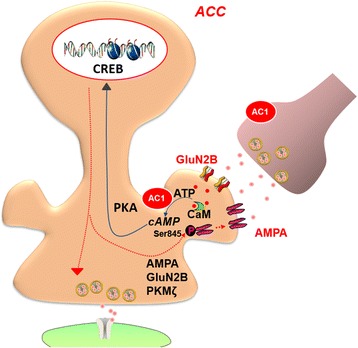Fig. 7.

A model showing the molecular mechanism for the upregulation of AMPA receptors in the ACC of IBS animal model. Visceral injuries trigger the release of glutamate in the ACC via ascending visceral pathways. Activation of NMDA receptors lead to calcium fluxes into the postsynaptic membrane. These cause the activation of Ca2+/CaM dependent AC1. Activation of AC1 catalyzes the conversion of ATP to cAMP and activates PKA and downstream signaling pathway, which in turn produces the phosphorylation of the GluA1-containing AMPA receptor at Ser845 site, GluN2B and PKMζ. The phosphorylation of the GluA1 at Ser845 site promotes AMPA receptor trafficking to membrane. Increases in postsynaptic AMPA receptors as well as the enhancement of glutamate release significantly enhance excitatory synaptic transmission in the ACC, and then lead to amplification of chronic visceral pain
